Geographies of 2019
The poster is divided into two. The lower half of the poster joined with yellow lines emphasizes the physical elements of the protest and highlights those who were actually physically present in the revolt. The poster illustrates how the protests extended relations across local towns in Mount Lebanon and into the main cities (Tripoli and Beirut). The upper half of the poster tied together with green lines focuses on the virtual with references to traditional and social media and the Lebanese diaspora around the world that keenly followed the protests.
- 1
Christina highlights her hometown of Baskinta, located 43 kilometres north-east of Beirut and one of the highest villages in the country. It was here that Christina experienced the protest first and where the physical and virtual experience of the protest overlapped for her.
- 2
Dunkin Donuts and Bashir are two food chains that are present throughout the country and became associated with the uprisings. They became sites of protests and crucial venues for protesters to get food.
- 3
Both Tripoli (on the left) and Beirut (on the right) are cited as the two most significant centers of the protest. The roses that lead to Tripoli refer to the city becoming known as "'Arous al-thawra" (the bride of the revolution).
Video
Christina Karam







